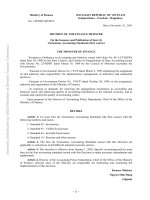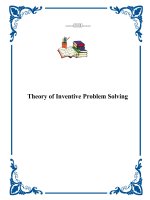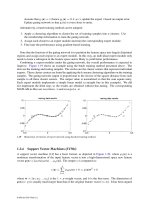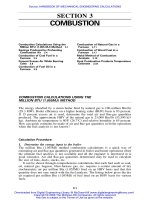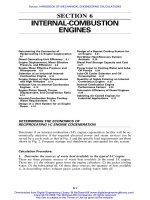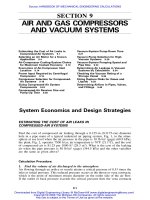Tài liệu Handbook of Criminal Justice Administration pdf
Bạn đang xem bản rút gọn của tài liệu. Xem và tải ngay bản đầy đủ của tài liệu tại đây (33.15 MB, 520 trang )
Handbook
of
Criminal
Justice
Administration
PUBLIC ADMINISTRATION AND PUBLIC
POLICY
2.
3.
4.
5.
6.
7.
8.
9.
10.
11.
12.
13.
14.
15.
16.
A Comprehensive Publication Program
Executive Editor
JACK
RABIN
Professor of Public Administration and Public Policy
School of Public Affairs
The Capital College
The Pennsylvania State University-Harrisburg
Middletown, Pennsylvania
Public Administration as a Developing Disc@line
(in
two parts), Robert T.
Golembiewski
Comparative National Policies on Health Care,
Milton
I.
Roemer, M.D.
Exclusionary Injustice: The Problem of Illegally Obtained Evidence,
Steven
R.
Schlesinger
Personnel Management in Government: Politics and Process,
Jay
M.
Shafritz, Walter L. Balk, Albert
C.
Hyde, and David H. Rosenbloom
Organization Development in Public Administration
(in
two parts), edited
by Robert T. Golembiewski and William B. Eddy
Public Administration: A Comparative Perspective, Second Edition, Re-
vised and Expanded,
Ferrel Heady
Approaches to Planned Change
(in
two parts), Robert T. Golembiewski
Program Evaluation at HEW
(in
three parts), edited by James G. Abert
The States and the Metropolis,
Patricia
S.
Florestano and Vincent
L.
Marando
Personnel Management in Government: Politics and Process,. Second Edi-
tion, Revised and Expanded,
Jay
M.
Shafritz, Albert
C.
Hyde, and David
H
. Rosen bloom
Changing Bureaucracies: Understanding the Organization Before Selecting
the Approach,
William A. Medina
Handbook on Public Budgeting and financial Management,
edited by
Jack Rabin and Thomas D. Lynch
Encyclopedia of Policy Studies,
edited by Stuart
S.
Nagel
Public Administration and Law: Bench v. Bureau in the United States,
David
H.
Rosenbloom
Handbook on Public Personnel Administration and Labor Relations,
edited
by Jack Rabin, Thomas Vocino, W. Bartley Hildreth, and Gerald
J. Miller
Public Budgeting and finance: Behavioral, Theoretical, and Technical Per-
spectives, Third Edition,
edited by Robert T. Golembiewski and Jack
Rabin
17.
Organizational Behavior and Public Management,
Debra W. Stewart and
1
8.
The Politics of Terrorism: Second Edition, Revised and Expanded,
edited
19.
Handbook of Organization Management,
edited by William B. Eddy
20.
Organization Theory and Management,
edited by Thomas D. Lynch
21
.
Labor Relations in the Public Sector,
Richard C. Kearney
22.
Politics and Administration: Woodrow Wilson and American Public Ad-
23.
Making and Managing Policy: Formulation, Analysis, Evaluation,
edited by
24.
Public Administration: A Comparative Perspective, Third Edition, Revised,
25.
Decision Making in the Public Sector,
edited by Lloyd G. Nigro
26.
Managing Administration,
edited by Jack Rabin, Samuel Humes, and
Brian
S.
Morgan
27.
Public Personnel Update,
edited by Michael Cohen and Robert T. Golem-
biewski
28.
State and Local Government Administration,
edited by Jack Rabin and
Don Dodd
29.
Public Administration: A Bibliographic Guide to the Literature,
Howard
E.
McCurdy
30.
Personnel Management in Government: Politics and Process, Third
Edition, Revised and Expanded,
Jay M. Shafritz, Albert
C.
Hyde, and
David H. Rosenbloom
31.
Handbook of Information Resource Management,
edited by Jack Rabin
and Edward M. Jackowski
32.
Public Administration in Developed Democracies: A Comparative Study,
edited by Donald C. Rowat
33.
The Politics of Terrorism: Third Edition, Revised and Expanded,
edited by
Michael Stohl
34.
Handbook on Human Services Administration,
edited by Jack Rabin and
Marcia B. Steinhauer
35.
Handbook of Public Administration,
edited
by
Jack Rabin,
W.
Bartley
Hildreth, and Gerald
J.
Miller
36.
Ethics for Bureaucrats: An Essay on Law and Values, Second Edition,
Revised and Expanded,
John A. Rohr
37.
The Guide to the Foundations of Public Administration,
Daniel W. Martin
38.
Handbook of Strategic Management,
edited by Jack Rabin, Gerald
J.
Miller, and W. Bartley Hildreth
39.
Terrorism and Emergency Management: Policy and Administration,
William L. Waugh, Jr.
40.
Organizational Behavior and Public Management: Second Edition, Revised
and Expanded,
Michael L. Vasu, Debra
W.
Stewart, and G. David Garson
41.
Handbook of Comparative and Development Public Administration,
edited
by Ali Farazmand
42.
Public Administration: A Comparative Perspective, Fourth Edition,
Ferrel
Heady
43.
Government Financial Management Theory,
Gerald
J.
Miller
G. David Garson
by Michael Stohl
ministration,
edited by Jack Rabin and James
s.
Bowman
G. Ronald Gilbert
Ferrel Heady
44.
Personnel Management in Government: Politics and Process, Fourth
Edition, Revised and Expanded,
Jay M. Shafritz, Norma M. Riccucci,
David H. Rosenbloom, and Albert
C.
Hyde
45.
Public Productivity Handbook,
edited by Marc Holzer
46.
Handbook
of
Public Budgeting,
edited by Jack Rabin
47.
labor Relations in the Public Sector: Second Edition, Revised and Ex
48.
Handbook of Organizational Consultation,
edited by Robert T. Golem
49.
Handbook of Court Administration and Management,
edited by Steven
50.
Handbook of Comparative Public Budgeting and Financial Management,
51
,
Handbook
of
Organizational Behavior,
edited by Robert T. Golembiewski
52.
Handbook
of
Administrative Ethics,
edited by Terry L. Cooper
53.
Encyclopedia of Policy Studies: Second Edition, Revised and Expanded,
54.
Handbook of Regulation and Administrative Law,
edited by David H.
55.
Handbook of Bureaucracy,
edited by Ali Farazmand
56.
Handbook
of
Public Sector labor Relations,
edited by Jack Rabin,
57.
Practical Public Management,
Robert T. Golembiewski
58.
Handbook
of
Public Personnel Administration,
edited
by
Jack Rabin,
59.
Public Administration: A Comparative Perspective, Fifth Edition,
Ferrel
60.
Handbook
of
Debt Management,
edited by Gerald
J.
Miller
61.
Public Administration and Law: Second Edition,
David H. Rosenbloom
62.
Handbook
of
Local Government Administration,
edited by John
J.
Gargan
63.
Handbook
of
Administrative Communication,
edited by James L. Garnett
and Alexander Kouzmin
64.
Public Budgeting and Finance: Fourth Edition, Revised and Expanded,
edited
by
Robert T. Golembiewski and Jack Rabin
65.
Handbook of Public Administration: Second Edition,
edited by Jack
Rabin,
W.
Bartley Hildreth, and Gerald
J.
Miller
66.
Handbook of Organization Theory and Management: The Philosophical
Approach,
edited by Thomas D. Lynch and Todd
J.
Dicker
67.
Handbook of Public Finance,
edited by Fred Thompson and Mark
T.
Green
68.
Organizational Behavior and Public Management: Third Edition, Revised
and Expanded,
Michael L. Vasu, Debra W. Stewart, and G. David Garson
69.
Handbook
of
Economic Development,
edited by Kuotsai Tom Liou
70.
Handbook of Health Administration and Policy,
edited by Anne Osborne
71
.
Handbook of Research Methods in Public Administration,
edited by
72.
Handbook on Taxation,
edited by W. Bartley Hildreth and James A.
panded,
Richard
C.
Kearney
biewski
W. Hays and Cole Blease Graham, Jr.
edited
by
Thomas D. Lynch and Lawrence L. Martin
edited by Stuart
S. Nagel
Rosenbloom and Richard D. Schwartz
Thomas Vocino, W. Bartley Hildreth, and Gerald
J.
Miller
Thomas Vocino, W. Bartley Hildreth, and Gerald
J.
Miller
Heady
and Rosemary O'Leary
Kilpatrick and James A. Johnson
Gerald
J.
Miller and Marcia L. Whicker
Richardson
73.
74.
75.
76.
77.
78.
79.
80.
81.
82.
83.
Handbook of Comparative Public Administration in the Asia-Pacific Basin,
edited
by
Hoi-kwok Wong and Hon
S.
Chan
Handbook
of
Global Environmental Policy and Administration,
edited by
Dennis
L.
Soden and Brent
S.
Steel
Handbook of State Government Administration,
edited by John J. Gargan
Handbook
of
Global Legal Policy,
edited by Stuart
S.
Nagel
Handbook
of
Public Information Systems,
edited by G. David Garson
Handbook
of
Global Economic Policy,
edited by Stuart
S.
Nagel
Handbook of Strategic Management: Second Edition, Revised and
Expanded,
edited by Jack Rabin, Gerald
J.
Miller, and
W.
Bartley Hildreth
Handbook of Global International Policy,
edited by Stuart
S.
Nagel
Handbook of Organizational Consultation: Second Edition, Revised and
Expanded,
edited by Robert T. Golembiewski
Handbook of Global Political Policy,
edited by Stuart
S.
Nagel
Handbook of Global Technology Policy,
edited by Stuart
S.
Nagel
14dditional
Vohmes
in
Preparation
Handbook
of
Global Social Policy,
edited by Stuart
S.
Nagel and Amy Robb
Handbook
of
Organizational Behavior: Second Edition, Revised and
Ex-
panded,
edited by Robert T. Golembiewski
Handbook
of
Administrative Ethics: Second Edition, Revised and Expanded,
edited by Terry
L.
Cooper
Handbook
of
Public Quality Management,
edited by Ronald J Stupak and
Peter
M.
Leitner
Handbook
of
Criminal Justice Administration,
edited by Ton1 DuPont-
Morales, Michael K. Hooper, and Judy
H. Schmldt
Labor Relations in the Public Sector: Third Edition,
edited by Richard
C
Kearney
Handbook
of
Crisis and Emergency Management,
edited by Ali Farazmand
Handbook
of
Public Management Practice and Reform,
edited by Kuotsai
Tom Liou
Handbook
of
Comparative and Development Public Administration: Second
Edition, Revised and Expanded,
edited by Ali Farazmand
Principles and Practices
of
Public Administration
[on-line text], edited by Jack
Rabin, Robert Munzenrider, and Sherrie Bartell
".""
"""".
Public
Administration: A Comparative Perspective, Sixth Edition, Revised
and Expanded,
Ferrel
Heady
ANNALS
OF
PUBLIC ADMINISTRATION
1
.
Public Administration: History and Theory in Contemporary Perspective,
2.
Public Administration Education in Transition,
edited by Thomas Vocino
3.
Centenary Issues
of
the Pendleton Act
of
1883,
edited by David H. Ro-
4.
Intergovernmental Relations in the
1988~~
edited by Richard
H.
Leach
5.
Criminal Justice Administration: Linking Practice and Research,
edited by
edited by Joseph
A.
Uveges, Jr.
and Richard Heimovics
senbloom with the assistance
of
Mark
A.
Emmert
William
A.
Jones, Jr.
Handbook
of
Criminal Justice
Administration
edited
by
M.
A.
DuPontdMorales
Michael
K.
Hooper
Judy
H.
Schmidt
Penn State University-Harrisburg
Middleto wn, Pennsylvania
MARCEL
MARCEL DEKKER,
INC.
DEKKER
NEW
YORK BASEL
ISBN: 0-8247-0418-5
This book is printed on acid-free paper.
Headquarters
Marcel Dekker, Inc.
270 Madison Avenue, New York, NY 10016
tel: 212-696-9000; fax: 212-685-4540
Eastern Hemisphere Distribution
Marcel Dekker AG
Hutgasse 4, Postfach 812, CH-4001 Basel, Switzerland
tel: 41-61-261-8482; fax: 41-61-261-8896
World Wide Web
The publisher offers discounts on this book when ordered in bulk quantities. For more
information, write to Special Sales/Professional Marketing at the headquarters address
above.
Copyright
0
2001 by Marcel Dekker, Inc. All Rights Reserved.
Neither this book nor any part may be reproduced or transmitted in any form or by any
means, electronic or mechanical, including photocopying, microfilming, and recording,
or by any information storage and retrieval system, without permission in writing from
the publisher.
Current printing (last digit):
10987654321
PRINTED IN THE UNITED STATES
OF
AMERICA
Preface
The enforcement of laws and the numerous tasks involved in establishing and
maintaining civility in our communities are daily challenges to the criminal jus-
tice system. The administration of justice has become a series of competing man-
dates that demand bravery, accountability, and service. The administration and
management of the criminal justice system have grown more complex for law
enforcement, courts, corrections, and victim services.
The purpose of this volume is to review the historical foundation for the
current agenda and develop a strategy for the future of criminal justice administra-
tion. Criminal justice now answers to local and global decrees regarding safety
and professional service. Along with these societal demands, the administration
of justice is mandated to be efficient, effective, and ethical. Research and aca-
demia have embraced a collaborative spirit because technology and scientific
advancements have developed explanations for patterns of criminal behavior.
Ironically, as the system advances
so
does the criminal element, and formulation
of strategies to address this reality is a constant challenge.
Criminal justice administration requires versatility to address the situational
dimensions between criminals and those they victimize. This volume is edited to
address the numerous perspectives that make up criminal justice administration:
prevention, intervention. due process, marginalized populations, international
consequences, and the demand for professionalism.
Part
I
contains foundational pieces and is appropriately titled Global and
Comparative Perspectives. The quintessential topic of ethics is examined within
the context of the criminal justice system's three principal components; police,
courts, and corrections. Trends in crime are examined, as are historical explanations
iii
iv
Preface
for the commission of crime. Part I concludes with an examination of the important
variations among the criminal justice systems of the nations of the world.
Part 11, Policing, examines principal policing elements. Community polic-
ing is analyzed in the context of its predecessor policing strategies. Two bulwarks
of policing-investigation and traffic operations-are given their due coverage.
Two “hot-button” topics, use of force and civil disorder, are dissected as a means
of understanding their dynamics.
Part 111, Courts, looks at the operation of the criminal courts. The review
begins with a discussion of the general principles of criminal law and summarizes
the elements of the more common criminal offenses.
A
separate chapter is dedi-
cated to the complexities
of
criminal procedure. Examination of the criminal trial
process is accomplished by emphasis on the explanation of legal and communica-
tion processes. Courts are also examined from a general perspective, not one
limited to criminal justice, because the judicial branch must simultaneously deal
with criminal and other subject matter.
Part IV, Corrections, examines the correctional process comprehensively.
Institutional corrections and alternatives to incarceration are thoroughly re-
viewed. Prisoner rights and capital punishment are controversial issues that re-
ceive focused analysis.
Part V, Special Topics, addresses prominent topics that emerged at the end
of the 20th century and are expected to remain areas to which substantial re-
sources will’be dedicated into the next millennium. Insights into the science
of
victimology open this section. Discussions of workplace violence and domestic
violence follow. Organized crime and white collar crime are discussed in the
context of their enormity and defining qualities. Terrorism is examined in the
light of its unique aspects, which present challenges from the initial investigation
through sentencing. Environmental crime is introduced through discussion of its
unique body of law and its administration and enforcement protocols. The discus-
sion
of
special topics concludes with a foray into an array of aspects of technology
in criminal justice administration.
M.
A.
DuPont-Morcdes
Michael
K.
Hooper
Judy
H.
Schmidt
Contents
Preface
Contributors
PART
I.
GLOBAL AND COMPARATIVE PERSPECTIVES
The Ethics of Criminal Justice Administration
Laura B. Myers
Trends in Crime
Ned Slone
A History of Criminological Thought: Explanations for
Crime and Delinquency
Barbaru
Sims
Comparative Criminal Justice
Mathieu Deflem and Amanda J. Swvgart
PART II. POLICING
5.
Community Policing: Past, Present, and Future
W.
T. Jordan and Mary Ann Zager
6. Managing Criminal Investigation
Brian
Forst
111
ix
1
17
31
51
69
95
v
vi
7.
8.
9.
Traffic Operations
Michael
E.
Donahue
and
Don A. Josi
Use
of
Force by Law Enforcement Officers
Greg Mever
Civil Disorder and Policing
Michael K. Hooper
PART III. COURTS
10. Criminal Law
Craig Hernrnens
1
1.
Criminal Procedure
Craig Hemrnens
12. Criminal Trial Process
Janice Schuetz
13. Evolution of Court Management
Kevin Lee Derr
PART IV. CORRECTIONS
14.
15.
16.
17.
18.
Evolution
of
the Correctional Process
Peter
M.
Wickman and Korni
Swaroop
Kumar
Probation
Tanmy A. King
Alternatives to Incarceration
Rachel Porter
Prisoner
Rights
Katherine J. Bennett
and
Craig Hemmens
Correctional Administration and Section 1983 Liability
Issues
Darrell
L.
Ross
Contents
123
147
159
167
185
205
223
249
269
285
303
319
Contents
19. Jail Administration and Management
Kenneth E. Kerle
20. Publicized Executions and the Incidence
of
Homicide:
Methodological Sources
of
Inconsistent Findings
Steven Stack
PART
V.
SPECIAL TOPICS
21.
22.
23.
24.
25.
26.
27.
28.
Victimology
M. A. DuPont-Morales
Workplace Violence: Prevention and Threat Assessment
Michael K. Hooper
Future Trends in Addressing and Preventing Domestic
Violence: The Role of Domestic Violence Coalitions
Bernadette
T.
Muscat
Organized Crime
Jefsrey P. Rush and Gregory P.
Owis
White Collar Crime
Richard A. Ball
Terrorism and the American System of Criminal Justice
Brent
L.
Smith, Kelly R. Damphousse, and Amy Karlson
Environmental Crime and Justice
Nanci Koser Wilson
Technology
in
Criminal Justice Administration
Valeria Coleman
vi
i
343
355
37
1
385
395
413
43
1
447
46
1
473
Index
499
This Page Intentionally Left Blank
Contributors
Richard
A.
Ball, Ph.D. Department
of
Administration of Justice, Penn State
University-Fayette, Uniontown, Pennsylvania
Katherine J. Bennett, Ph.D. Department of Criminal Justice, Social, and Polit-
ical Science, Armstrong Atlantic State University, Savannah, Georgia
Valeria Coleman,
J.D.
Department of Law and Legal Studies,
Morris
Brown
College, Atlanta, Georgia
Kelly R. Damphousse, Ph.D. Department of Sociology, University
of
Okla-
homa, Norman, Oklahoma
Mathieu Deflem, Ph.D. Department of Sociology and Anthropology, Purdue
University, West Lafayette, Indiana
Kevin Lee Derr, J.D. Policy Department and Research Office, Senate of Penn-
sylvania, Harrisburg, Pennsylvania
Michael
E.
Donahue, Ph.D. Department of Criminal Justice, Social, and Polit-
ical Science, Armstrong Atlantic State University, Savannah, Georgia
M.
A.
DuPont-Morales, Ph.D. School of Public Affairs, Penn State Univer-
sity-Harrisburg, Middletown, Pennsylvania
ix
X
Contributors
Brian Forst, Ph.D. School of Public Affairs, American University, Washing-
ton, D.C.
Craig Hemmens, J.D., Ph.D. Department of Criminal Justice Administration,
Boise State University, Boise, Idaho
Michael K. Hooper, Ph.D. School
of
Public Affairs, Penn State University-
Harrisburg, Middletown, Pennsylvania
W.
T. Jordan, Ph.D. Division of Criminal Justice, Florida Gulf Coast Univer-
sity, Fort Myers, Florida
Don
A.
Josi, Ph.D. Department of Criminal Justice, Social, and Political Sci-
ence, Armstrong Atlantic State University, Savannah, Georgia
Amy Karlson University of Alabama at Birmingham, Birmingham, Alabama
Kenneth
E.
Kerle, Ph.D. American Jail Association, Hagerstown, Maryland
Tammy A. King, Ph.D. Department
of
Criminal Justice, Youngstown State
University, Youngstown, Ohio
Korni Swaroop Kumar, Ph.D. Department of Sociology, State University of
New York, College at Potsdam, Potsdam, New York
Greg Meyer, M.S. Police Tactics Consultant, Downey, California
Bernadette
T.
Muscat, M.P.A. Department of Behavioral Sciences, York Col-
lege of Pennsylvania, York, Pennsylvania
Laura B. Myers, Ph.D. College of Criminal Justice, Sam Houston State Uni-
versity, Huntsville, Texas
Gregory P. Orvis, J.D., Ph.D. Department of Social Sciences, University of
Texas at Tyler, Tyler, Texas
Rachel Porter Vera Institute of Justice, New York, New York
Darrell L.
Ross,
Ph.D. Department of Criminal Justice Studies, East Carolina
University, Greenville, North Carolina
Contributors xi
Jeffrey P. Rush, D.P.A. University of Tennessee at Chattanooga, Chattanooga,
Tennessee
Janice Schuetz Department of Communication, University of New Mexico,
Albuquerque, New Mexico
Barbara Sims, Ph.D. School of Public Affairs, Penn State University-Harris-
burg, Middletown, Pennsylvania
Neal Slone, Ph.D. Department of Sociology, Social Welfare, and Criminal Jus-
tice, Bloomsburg University of Pennsylvania, Bloomsburg, Pennsylvania
Brent
L.
Smith, Ph.D. Department of Justice Sciences, University
of
Alabama
at Birmingham, Birmingham, Alabama
Steven Stack, Ph.D. Department of Criminal Justice, Wayne State University,
Detroit, Michigan
Amanda
J.
Swygart, M.S. Department of Sociology and Anthropology.
Purdue University, West Lafayette, Indiana
Peter M. Wickman, M.A.Ed.D. Department of Sociology, State University of
New York, College at Potsdam, Potsdam, New York
Nanci Koser Wilson Department
of
Criminology, Indiana University
of
Penn-
sylvania, Indiana, Pennsylvania
Mary Ann Zagar, Ph.D. Division of Criminal Justice, Florida Gulf Coast Uni-
versity, Fort Myers, Florida
This Page Intentionally Left Blank
The Ethics
of
Criminal Justice
Administration
Laura
B.
Myers
Sam Houston State University, Huntsville, Texas
1.
INTRODUCTION
The focus on criminal justice ethics training and education has grown over the
past two decades, resulting in mandatory ethics training within agencies and re-
quired ethics courses in many academic programs. The unnecessary beatings of
suspects by police officers, the deaths of inmates at the hands
of
correctional
officers, and the misconduct of lawyers and judges have all contributed to an
increasing dissatisfaction with criminal justice. This concern has not just emerged
from within the discipline but also from the demands placed on the discipline
by society.
As
the unethical behaviors of criminal justice practitioners have come
to public attention, citizens have demanded change.
As
the 20th century has ended, the concern regarding criminal justice ethics
has turned to a focus on the hiring and retention of criminal justice practitioners
who will make better decisions at critical times. This process will not happen
overnight and has become a major issue for criminal justice administrators as
they daily confront newly developing ethical dilemmas.
This chapter will first briefly review the history of criminal justice ethics
within the discipline of criminal justice. Second, some major theories used to
guide criminal justice ethics will be presented. Third, the areas of policing, courts,
and corrections will be analyzed to highlight major ethical dilemmas and potential
solutions to those issues. Finally, the last part of the chapter will present several
current ethical issues facing criminal justice and their impact
on
both the disci-
pline and the community.
1
2
Myers
II.
HISTORY
OF
CRIMINAL JUSTICE ETHICS
The concern for criminal justice ethics results from the interdisciplinary nature
of the criminal justice discipline (Kleinig and Smith, 1997). Because criminal
justice includes the vocational aspects of criminal justice practice, there is con-
cern for the actions of the practitioner. The early emphasis of criminal justice
ethics began in policing. As funding increased for police education, the concern
for police quality grew and with it the need for emphasis on law enforcement
ethics (Sherman, 1978).
As ethics training and education developed, a distinction between philo-
sophical and applied ethics emerged (Kleinig and Smith, 1997). The first, philo-
sophical ethics, made use of classical and modern philosophical theories that
apply to practitioner behavior to support rules for ethical behavior. The writings
of Plato, Socrates, Aristotle, Bentham, Mill, Kant, and others were used to de-
velop rationales for ethical choices in criminal justice work (Souryal, 1992).
The second, applied ethics, helped guide professional and appropriate be-
haviors expected in criminal justice. Applied ethics drew on the writings of phi-
losophers but in a more limited manner than philosophical ethics. It also used
the contributions of administrative theorists, behaviorists, and even psychologists
to understand the behaviors
of
practitioners to guide their ethical choices.
111.
THEORIES USED IN CRIMINAL JUSTICE ETHICS
While many theoretical approaches have been used to guide criminal justice eth-
ics, a review of some of the current texts reveals a common reliance on utilitarian-
ism and deontology (Braswell et al., 1996; Pollock, 1994; Souryal, 1992). Other
approaches appear less often but prove useful in the understanding of behaviors
and in the guidance of appropriate behaviors. The approaches include peacemak-
ing, religious ethics, the ethics of virtue, and moral development theory.
A.
Utilitarianism
Utilitarian theory proposes that moral action is action providing the greatest good
for the greatest number of people. Therefore, based on the writings of Jeremy
Bentham (1970) and John Stewart Mill (1979), the ethical decisionmaker will
engage in a mental process of measuring the pros and cons
of
the potential action
and choose that which proves best for the majority (Braswell et al., 1996).
B.
Deontology
The study of duty serves as the basis for deontological theory, which assumes that
the only moral action
is
one done for the sake
of
duty. Deontology emphasizes the
The Ethics
of
Criminal Justice Administration
3
difference between the hypothetical and categorical imperatives. The hypothetical
imperative permits the decision maker to review the options. However, the cate-
gorical imperative is the moral imperative and gives the decisionmaker no option:
a person who takes an oath to perform particular duties must fulfill those duties
within specific guidelines.
Two formulations of the categorical imperative are especially helpful in
guiding ethical choices for persons who have duties to fulfill (Kant, 1964). The
first formulation is universalizability, meaning that decisionmakers cannot make
themselves exceptions unless they are willing that all others be allowed the same
choice. Law enforcement officers, for example, cannot break the law and enforce
the law at the same time.
The second formulation is that humans have intrinsic value and must not
be used as a means to an end. In this case, criminal justice practitioners, guided
by their sense of duty, must accomplish their goals while resisting the temptation
to use others in the achievement of those goals. Defense attorneys, for example,
must resist the temptation to humiliate a victim unnecessarily in defending the
accused.
C.
Peacemaking
Peacemaking is a more recent addition to criminal justice ethics. It is a holistic
approach to guiding behavior with the intent of triggering an appreciation for the
role individuals play in human interactions. Three aspects of peacemaking in-
clude connectedness, care, and mindfulness.
1.
Connectedness
Connectedness reminds individuals that actions have consequences. People
should choose behaviors resulting in minimizing harm to others and the environ-
ment. If individuals fail to recognize the potential of their actions to harm others,
the consequences of those bad choices will likely cause future harm, which ech-
oes the Hindu concept of karma (Braswell et al., 1996).
Criminal justice practitioners who make decisions without regard for the
consequences can create harm to others.
A
police officer, for example, who bru-
talizes a minority group suspect can create ill-will in the community.
A
defense
attorney who degrades a rape victim during the trial of the rapist is revictimizing
the victim. Such actions accomplish goals for the practitioner, but they cause
bigger problems for the system.
2.
Care
The notion of care comes from the work of Ne1 Noddings (1986) and describes
the masculine and feminine approaches to behavioral choices. The masculine
4
Myers
approach is premised on analysis, logic, and rationality, while the feminine ap-
proach is premised on the concepts of nurturing, care, and responsiveness.
Noddings explains that society has traditionally championed the masculine
approach as the more successful method of decision making. However, she argues
that while the masculine approach works in many cases, it ignores the contribu-
tions of the feminine approach. She suggests that the feminine approach is actu-
ally the more natural manner by which to resolve dilemmas.
The feminine approach is a useful complement to the masculine approach
in criminal justice decision making. Police officers, for example, who respond
to domestic violence calls can make an arrest when necessary, which is a rational
response to domestic assault. Arrest, however, does not always solve the problem
and officers find themselves continually returning to the same address. The re-
sponsive approach of counseling the female victim has reduced the number of
return calls to the same address and has even reduced the number of domestic
homicides. Such counseling involves suggesting that the victim remove herself
from the home, perhaps going to a shelter, and seeking counseling at least for
herself (Myers and Chiang, 1993).
3.
Mindfulness
Mindfulness is a simple component of peacemaking that reminds individuals to
think with their minds and their hearts. When people think only with their minds,
they may forget the compassion and emotions needed to make better decisions.
Logic alone is not sufficient. Individuals should take into account how others
might feel, how others may perceive their decisions, and the actual impact of
their decisions on all others (Braswell et al., 1996).
Correctional officers, for example, who work with death row inmates
awaiting execution can treat such inmates as objects or they can show compassion
and treat these inmates as humans. Showing compassion does not mean acting
leniently. The correctional officers have the task of working with inmates who
must be put to death. They do not have to make the situation worse than it is.
In fact, it is not their job to make it worse.
D.
Religious
Ethics
Religious ethics, probably the most common source of ethical guidelines in use,
is derived from religious teachings and beliefs. Most sources of religious ethics,
including Christianity, assume the presence of a god with the concepts of good
and evil derived from that god. Followers of religious ethics respect the authority
of their god and receive their guidelines on moral behavior from the particular
teachings and interpretations of their doctrine (Pollock, 1994; Souryal, 1992).
The Ethics of Criminal Justice Administration
5
Many professionals, including some criminal justice practitioners, use their
religious value systems to guide their decisionmaking in the workplace. Instead
of following the ethical guidelines of their profession, they use the often higher
standards
of
their own religious values.
E.
The Ethics
of
Virtue
The ethics
of
virtue assume several virtues possessed by individuals, enabling
them to make the right choices. Moral virtue is based on character rather than
logical reasoning. Instead
of
choosing to do the right thing, virtuous people pos-
sess positive character traits that allow them to resist temptations (Pollock,
1994).
A virtuous police officer, for example, would not even think about pocketing
some of the cash from a drug bust. For some officers, taking some of the cash
could be justified on utilitarian grounds. The virtuous officer, possessing the traits
of honesty and humility, would not even think of him- or herself when faced
with the cash.
F.
Moral
Development Theory
The discipline
of
psychology has contributed much to ethical decision making
with an understanding of the role of cognitive development in behavior choices.
The premise is that moral development is consistent with the levels of cognitive
development that a person grows through from infancy to adulthood. At the lower
levels of cognitive development, the person has little moral reasoning ability. An
infant, for example, has no conception
of
right or wrong.
These concepts must be taught and can only be taught as the child’s cogni-
tive abilities develop to
a
level that permits such learning.
As
youths progress
toward adulthood, their cognitive abilities permit them to learn about their world
using simple dichotomies, allowing for a vast understanding of many important
concepts such
as
right and wrong, good and evil, life and death, and others.
As the brain continues to develop, the person begins to realize that these
simple dichotomies were only a heuristic device for understanding the complexity
of the world. Actually, the world is so complex that the shades of gray between
these simple dichotomies must be acknowledged. According to moral develop-
ment research, most individuals never reach this higher level of cognitive devel-
opment that allows them to appreciate these complexities or to understand their
role within a universal environment. Society compounds the problem by teaching
everything in dichotomies and rarely reaches beyond the simplistic to help indi-
viduals understand the world.
Failure to reach the higher levels
of
cognitive development means that
many people do not achieve proper levels of moral development. Individuals with
mental development problems, poor learning environments, or both, are noted for
6
Myers
making bad choices. The application of this theory to criminal justice decision
making is quite simple. If individuals do not have proper levels of cognitive
development, for whatever reasons, they may be expected to make poor moral
decisions (Pollock-Byrne, 199
1).
IV.
APPLICATION
After reviewing some
of
the major theoretical approaches, it is important to un-
derstand the application of those theories to the critical areas of policing, courts,
and corrections. Each of the theories previously reviewed was developed outside
of the criminal justice discipline and has been applied to criminal justice by crimi-
nal justice scholars engaged in criminal justice ethics research and writing. The
following sections are an overview of the major applications.
A.
Police
Law enforcement has received the most attention regarding ethics in the criminal
justice field primarily because of the historical development of the discipline.
This does not mean that ethical issues have not plagued courts and corrections
just as long. Law enforcement, in an effort to increase quality and achieve profes-
sional status, has attempted to improve the decision making of officers.
1.
Deception
Because criminal behavior is deceptive and often requires deception to resolve
it, police work is inherently deceptive. In an article by Skolnick
(1982),
he ex-
plains the three stages in which police deception occurs: investigative deception,
interrogation deception, and testimonial deception. Investigative deception is de-
ception used to determine the circumstances of a crime and may involve lying
to a witness or victim to obtain information. Investigative deception is most ac-
ceptable because there are few rules or laws prohibiting use of deception
in
ob-
taining basic information.
However, at the interrogation stage, the amount of deception increases and
is accepted less. Before the
M~IYZJZ~LI
and
Mcrpy
decisions, law enforcement inter-
rogation might have involved the overt pressure of beatings and threats to obtain
information. But, with an increased emphasis on individual rights, the
Mirclnda
and
Mupp
decisions forced officers who used these tactics to become more covert
and engage in psychological tactics, such as good cop/bad cop to obtain informa-
tion.
So
while it was less acceptable to use interrogation deception, some officers
still found a way to get their information using deceptive practices.
